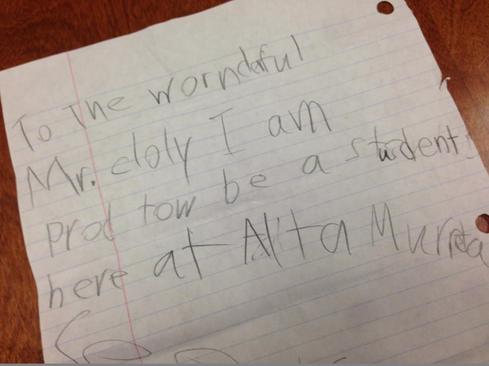 Email is great. And it’s not. It’s a tool that enables us to electronically communicate with someone on the other side of campus or the other side of the world, with just a few keystrokes and mouse click or a few taps on our phones. Unfortunately, it’s also something that can blur, if not altogether erase, the boundary lines that separate our work and personal lives. Email provides us the ability to stay connected in a way that was unheard of before its invention in 1971. It allows us to work remotely and into the evening. It means we can take care of business from our phones, all while sitting on the couch at home, in line at the grocery store, or at our son’s or daughter’s soccer practice. While there are times when we may need to answer emails away from the office, the problem exists when we let email control us, when we feel like we have to answer emails from home, in the grocery store, at our kids’ practices, or late at night. Email is a powerful tool, but it can control us if we allow it. In my position, I get a ton of email, and I used to struggle with the urge to constantly check to see if I had any new messages. For me, taking back control began with turning off notifications. Whether that was the audible bell that rang on my desktop or laptop each time a new message arrived, or notifications on the email app on my phone and iPad, I turned them off. That’s right. I turned them off. “But you’re a principal,” you might be thinking. “You can’t turn off your notifications.” Yes, I am, and yes, I can. I did it. I turned off my email notifications. And it’s been one of the most important professional decisions I’ve made, one that has substantially helped manage my level of stress and improved my mental well-being. It’s amazing how compelling that little red number in the upper, right-hand corner of the email icon can be, how much power it can possess. When I had notifications on and the red number would appear, indicating a new message had arrived, it was as if that number was whispering to me, “You’re missing something. Don’t you want to know what this new message says?” And more often than not, I gave in to the compulsion and checked my messages, even if it was late in the evening, on the weekend, or while I was spending time with my family. Email was controlling me. Notifications had erased the boundary between work time and personal time. So I turned them off. I banished this digital bully to the virtual abyss with a simple swipe in the app’s settings. Now, let me be clear. I still check my email frequently. I’m a site principal, so I am tasked with keeping the lines of communication open with stakeholders. I’m responsible for responding to email in a timely fashion, and I do. I still check my email. I check it a lot! But I check it on my schedule. If it’s an emergency or something that needs an immediate response, I can be reached by text or phone. District personnel and my school staff have my cell phone number and know not to hesitate to text or call if it’s something urgent. But if it’s an email, I’ve learned that it’ll keep until I check it. It’s important to note that this idea of taking back control is not limited to email. It extends to apps like Remind, Seesaw, ClassDojo, and text messaging. Teachers, these digital tools are fantastic ways to stay in contact with your students and their parents. But please be careful, as they too can control you if you allow them to. Just because you can respond to the message a parent sends at 10:00 p.m. doesn’t mean you should. It’s like feeding a stray cat -- if you feed it, it will keep coming back, expecting you to continue feeding it. In the same way, feeling compelled to respond to a parent’s message late in the evening, well after work hours have concluded, can lead to parents expecting a response right away...even though 10:00 p.m. is clearly outside of the time we should be expected to be working (and would expect parents to answer any of our questions). Bottom line, in my experience, I’ve found that rarely has checking my email at 10:00 p.m. contributed to a good night’s sleep. Whatever is lurking in messages sent late at night will keep until morning. My purpose in writing this post is not to imply that responding to messages in a timely fashion isn’t important. It’s incredibly important! My point is that we have to set boundaries. After work, it’s OK to set the computer, tablet, or phone aside so you can devote your full attention to family, friends, and your own well being. It’s more than OK -- it’s necessary. You can be a great teacher or administrator and still devote time for your personal life. And that’s not something to feel guilty about. If you’ve been struggling with setting boundaries in the area of email and other communication apps, consider this post permission to take back control. Remember, if it’s an emergency, whoever it is will find a way to get a hold of you right away. If not, it’ll keep until morning.
0 Comments

Dream small.
“Wait, what? Dream small?” you may be thinking. “I thought we were supposed to dream big. I thought we were were supposed to have big dreams.” We are. But we also need to dream small. Let me explain. Recently, a song I had never heard before made its way into my earbuds as a Spotify suggested tune. The song is called “Dream Small” by Josh Wilson. As I listened, the lyrics completely resonated with me, especially this second verse:
“It’s visiting the widow down the street
Or dancing on a Friday with your friend with special needs These simple moments change the world Of course there’s nothing wrong with bigger dreams Just don’t miss the minutes on your way to bigger things ‘Cause these simple moments change the world”
As I listened, it made me think of what we do in education. We have so many big goals for our students, and rightfully so. Teaching them to read and write. Helping them master the various components of mathematics. Building responsibility and character. Preparing them for college and the workforce. All important things for sure. Make no mistake, these should be our goals for our students.
But this song served as an excellent reminder that we cannot overlook the small things on the journey to our bigger goals, for it’s the little things that often times have the biggest impact. A smile. A high-five or fist bump as students enter your classroom each day. An encouraging pat on the back. An observant comment such as “I like your shoes. Are those new?” or “Did you get your hair cut?” Asking about a student’s weekend, and then giving your undivided attention as he or she tells you about it. These simple moments can change a student’s world. These simple acts can make students feel valued, feel loved, something far more important than a perfectly executed lesson. It’s so easy to get bogged down with all we have to do — the demands on teachers and administrators are great. We are responsible for a ton! But let us not forget the power contained in a smile, a compliment, or a few moments of undivided attention. Let us not forget to dream small. Even a tiny pebble can create a large ripple. Or as another verse in the song says,
“A tiny rock can make a giant fall.”

As educators, we make a difference every single day in the lives of those we serve. I know, I know. This isn’t groundbreaking news. This also just in -- water is wet.
There are times when we know we’re making a difference. Like those times when you see the light bulb go on in a student, when he/she “gets it.” When targeted intervention results in a student’s reading level significantly rising over the course of the school year. When you see a student light up after a word of praise. When you receive a hand-drawn picture from a first grader telling you she’s happy to be at your school. These moments remind us of our impact. But what about the times we don’t see the fruits of our labor? What about when we don’t hear the words of appreciation for what we do, or the student’s reading level doesn’t rise the way we would have hoped? Does that mean we’re not making a difference? Absolutely not! Yes, there are times when our impact will be clearly seen, but there are also times when we will have no clue how powerful our influence is on those we serve. Let me illustrate. At the end of this past school year, I took an incredible idea from the amazing John Eick and tried it with my staff. I created a Google Form that asked our students, parents, and staff to write a few words of encouragement to one or more of our staff members, and the responses from the form were then merged into individual messages of appreciation and emailed to staff members. People need to feel appreciated, so I thought this would be a great way for staff to feel the love after working so hard all year. To say the idea was a success would be an understatement, as we had over 1,000 responses, generating over 1,000 messages of appreciation! To hear more about this idea and how we did it, take some time to listen to my conversation with John in Episodes 20 and 23 of my podcast Teaching Tales. Here's my point in sharing this. One of the messages of appreciation I received was from one of our promoting 5th grade students. She wrote:
“Thank you Mr.Coley for helping me up on the first day of 5th grade when I fell.”
As the principal of an elementary school, students see me do a lot, like opening gates, supervising drop-off and dismissal, visiting classrooms, leading weekly Friday Flag assemblies, and hanging out with students during recess. But of all the things I did this past year, what this student remembered was that I helped her up after she fell on the first day of school. That act may not seem like much, but it made enough of an impact on her that 10 months later, that’s what she wanted to thank me for. And you know what? I don't remember doing this. I have no recollection of helping her up after she fell. But she does, and that's what matters.
I frequently say that kids watch everything we do. They watch, and they remember, even if we don't. Receiving this student's message reminded me it’s the little things that can often make the biggest impact. My friend Cori Orlando recently shared with me a short Ted Talk that perfectly illustrates this idea that we can make a huge difference in the lives of those around us, even when we don’t realize it. I encourage you to take six minutes to watch, and then ask yourself, “What’s my lollipop moment?” 
For two and a half years, I've had the absolute privilege of serving as an elementary school principal. I love my job. As I've previously written, there are tons of perks to my position. Knee-high hugs from kindergarteners. Being greeted each morning by smiling faces on students eager to learn. Working with dedicated teachers and staff who do whatever it takes to see students succeed. Connecting with students and their families. My job is awesome. I am blessed.
But can I be honest? I often feel inferior as it relates to what I do. I'm a lifelong learner. That means I like to find new ways to become better at what I do. That means I frequently dive into the pool of digital professional development known as Twitter, consistently finding inspiration and resources from members of my Professional Learning Network (PLN). That means I attend educational technology conferences and edcamps as often as I can to learn how to better leverage technology to enhance student learning. This week I had the opportunity to attend the Leadership for the Learning Symposium in San Jose. Over the course of the three days, I was inspired by Jamie Casap, Eric Sheninger, Wes Kieschnick, and others. That means I read fellow educators’ blogs and watch TED Talks on leadership and teaching, looking to be inspired, to learn something new. And you know what? I find what I’m looking for in all these places. I am consistently amazed by the #eduawesome teachers and administrators I meet at conferences, follow and interact with on Twitter, and work alongside in my district. I frequently think, "Oh my gosh! Look at the Incredible things he/she is doing with students/staff!" Unfortunately, this sometimes leads to the thought "I'm not doing that with my students/staff.” That can then lead to the thought “Someone’s going to find out and realize I’m not as good as (Person A) or (Person B)." I feel inadequate by comparison. As I was sitting in the San Jose airport waiting for my flight home, I was reflecting on the conference I had just attended. As I was reviewing my notes and tweets about the event, I started to slip into that negative line of thinking referenced above. And you know what snapped me out of it? American Idol. Wait, what? American Idol? Yep, American Idol. Let me explain. American Idol is in its final season and currently airing the audition stage of the competition, where hopeful contestants try to impress the three judges with their singing ability and earn a “ticket to Hollywood.” If you’ve been watching the show, you may have seen Melanie Tierce audition in San Francisco. Melanie is from my city of Murrieta and leads worship at my church, so it was cool to see someone I actually know on American Idol. American Idol for crying out loud! And she rocked her audition. She gave J-Lo “goosies,” brought Keith Urban to tears, and had Harry Connick tell her, “That was absolutely stunning.” If you missed her audition, you can watch it here. So back to me in the airport, starting to slip into the abyss of self-doubt. To try and clear my head, I pulled out my phone to check Facebook and came across a local news article about Melanie’s audition. In the article, Melanie was interviewed and asked about her biggest challenge trying out for the show. She responded with this:
“I didn’t know the level of talent would be so high. You constantly have to remind yourself of what you have in what you’re able to bring, and know that it is not stolen by other people having such a high caliber of talent.”
Though Melanie was referring to the talent on American Idol, her quote resonated with me. Just because there are a bunch of other talented singers on the show doesn’t diminish Melanie’s talent. The same idea is true for me. Just because others are doing incredible things in their schools doesn’t mean what I’m doing isn't good as well. Just because (Person A) rocks, that doesn’t mean I stink! Should I strive to improve as a leader? Absolutely! Should I emulate best practices and try to incorporate them in my own school? Without a doubt. But I shouldn’t do it by playing the dangerous game of “Who’s Better?” That game has no winner. I’m challenging myself to remember Melanie’s words of wisdom and not play the comparison game. If you sometimes beat yourself up in the same way, I challenge you to remember them too. We cannot let the talent/experience/skills of others rob us of what we bring to the table in our own schools. As we travel on the road to excellence, let us not lose sight of the good we are doing, the positive impact we’re making as we travel on this path. 
I love Google Forms. As an elementary school principal, I use them all the time. All. The. Time. From a parent contact log to gathering staff meeting feedback to finding out which parents are interested in joining our PTA Board, I use Google forms on a daily basis. If you're not already familiar with this powerful tool, check out this series of tutorial videos on what has become my favorite online tool.
The great thing about a Google Form is that the data gathered from the form is neatly organized in a Google Spreadsheet (A.K.A. Google Sheet) that can then be sorted and/or filtered. Last year I created two new Google Forms my teachers could use to submit their agendas and notes from their weekly Professional Learning Community (PLC) meetings. My goal was to provide teachers an easy-to-use method of submitting their grade level's agenda and notes while providing me a central location for all their responses. It worked great. I had one form and corresponding spreadsheet for their PLC agendas and one form and spreadsheet for their PLC notes. Each week, I could sort the responses by grade level to see what each team was working on. The problem came as the year progressed. With each passing week, more and more responses populated each spreadsheet. While I was able to sort the data by grade level, I still had to do a lot of scrolling due to the growing number of responses and large amount of text in some of the fields. What I needed was a way to filter the data for each grade level into a different worksheet (or tab) within the same spreadsheet. That's when I discovered EZ Query. EZ Query is a free add-on for Google Sheets that enables you to create different worksheets (tabs) within one spreadsheet that show only the data you want. This easy-to-use add-on makes the already-amazing Google Forms/Sheets combination even better. Rather than write about how it works, allow me to show you in the short video below. Enjoy!  Over the course of my career in education, I've learned numerous strategies and received countless tips and pieces of advice on how to be a great teacher. So many things go into being an effective educator, and in this post I want to share one small thing I learned way back in 1994. I was taking a college course on physical education for prospective teachers, and one day the instructor shared with the class what I consider to be one of the simplest yet best teaching tips I've ever received. The class was meeting outside on the grass field one day, and before beginning her lesson, the instructor looked up into the sky, adjusted where she was standing in relation to the students, and then told the class something I've never forgotten -- "Never have your students face the sun." So simple, yet so powerful. Think about it. You're outside with your students giving them directions about an activity the class is about to begin. If your students are looking into the sun, they're more than likely going to be distracted by the blinding light of that large fireball in the sky. They're probably thinking, "Man, this sun is bright!" If they're distracted by the sun in their eyes, they're not completely listening to you. They may be quiet, but through squinted eyes, they're probably not fully engaged. Plus, it's simple courtesy. You have sunglasses, your students don't. We learned at a young age not to stare at the sun. Let's not make our students do so when our classroom is the great outdoors.  It’s been a little more than a year since I began serving as an elementary school principal, and as I reflect on my time spent in this position, one thing is clear -- this is a hard job. Don’t get me wrong. While difficult, it is also incredibly rewarding. My district’s superintendent, as we were walking through classrooms a few weeks ago, said something that is so true -- “Being an elementary school principal is as close to being a rock star as one gets.” As an assistant principal at a middle school, students ran away from me, the disciplinarian. As an elementary principal, students run to me. Being an elementary school principal definitely has it’s perks. Like hugs. If riches were measured in side hugs, I’d be very wealthy. Or dozens and dozens of finger waves each day. Those of you at the elementary school level know what I’m talking about. Or walking across campus and hearing your name spoken in unison by a group of students headed to the library or lunch. “Mr. Coley! Mr. Coley! Hi, Mr. Coley!” Or greeting students and parents at the front gate each morning with a high five, seeing their smiling faces, eager to learn. Or sitting in a kindergarten classroom. If you’re ever having a bad day, go sit in a kindergarten classroom for a little while. It’ll make you smile. Trust me. Or riding tricycles with kindergarteners, as seen in the video below. But being a principal is hard too. People often ask me, “What’s the hardest part?” Is it the long hours? No. Is it the stress? Definitely a stress-filled position, but no. Is it having to handle student discipline? No. Not fun, but not the hardest part. Is it speaking with upset parents? No. Again, definitely not fun, but not the hardest part. For me, the hardest part of being a principal is...wait for it... Feeling powerless. Wanting to help but not being able to do so. I moved into administration because I had a desire to support teachers, which in turn helps students and their parents. By providing support and encouragement at this level, I have the potential to affect change on a larger scale than I could in a single classroom. But what happens when I'm not able to help? What happens when the desire is there, but what is required is beyond my reach? Like when teachers come to me requesting additional staffing, but such hiring decisions are out of my hands. Or when some of our classroom computers are eight years old, and a limited budget makes the replacement process a painfully slow one. Or when a teacher comes to me needing a new lamp for her LCD projector, but the lamps I've ordered over a month ago haven't yet arrived and there are none available to borrow. Or when parents come to me with legitimate safety concerns regarding our parking lot, yet those concerns stem from other parents not following the rules or being courteous. How do I mandate manners? Or when a teacher asks me to work with that hard-to-reach student, but none of the tricks in my bag are working. This is the hardest part of my job. Wanting to help but lacking the expertise or resources to do so. It’s frustrating. I sometimes wonder if I’m making a difference, if I’m being a good leader. Last week a student handed me this note at dismissal time. I must be doing something right.
|
About BrentBrent has worked in the field of education as a teacher and administrator for 28 years. A former elementary school teacher and principal, he is currently Coordinator of Elementary Education in the Murrieta Valley Unified School District in Southern California. Read more about Brent here. Brent on X (Twitter)Archives
May 2024
Categories
All
|
Photos from somegeekintn, woodleywonderworks, Joybot, British Council Singapore, jseliger2, berkuspic, toddwendy, Alexandra E Rust, skippyjon, crdotx, tharrin, roybuloy, .FuturePresent., Just some dust, frankpierson, Jair Alcon Photography, Luigi Mengato, Muffet, stevendepolo, Pilar Soro, Sander van der Wel, jblyberg, jonathangarcia, DraXus, angeloangelo, Sthetic



 RSS Feed
RSS Feed
